一、实验目的
1.能够运用 wireshark 对 OpenFlow 协议数据交互过程进行抓包;
2.能够借助包解析工具,分析与解释 OpenFlow协议的数据包交互过程与机制。
二、实验环境
1.下载虚拟机软件Oracle VisualBox;
2.在虚拟机中安装Ubuntu 20.04 Desktop amd64,并完整安装Mininet;
三、实验要求
(一)基本要求
1.搭建下图所示拓扑,完成相关 IP 配置,并实现主机与主机之间的 IP 通信。用抓包软件获取控制器与交换机之间的通信数据包。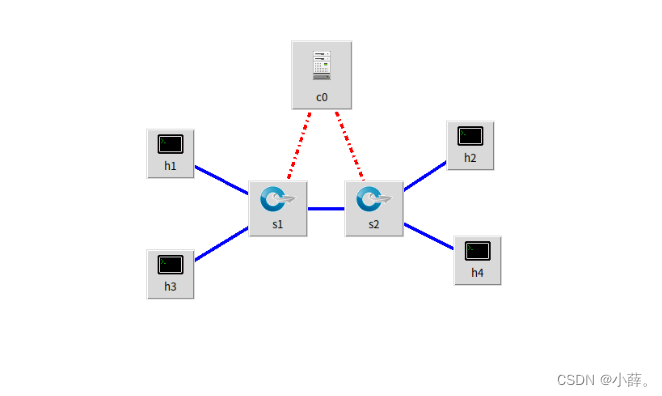
| 主机 | IP地址 |
| h1 | 192.168.0.101/24 |
| h2 | 192.168.0.102/24 |
| h3 | 192.168.0.103/24 |
| h4 | 192.168.0.104/24 |
- 在终端输入sudo ./../mininet/examples/miniedit.py搭建拓扑
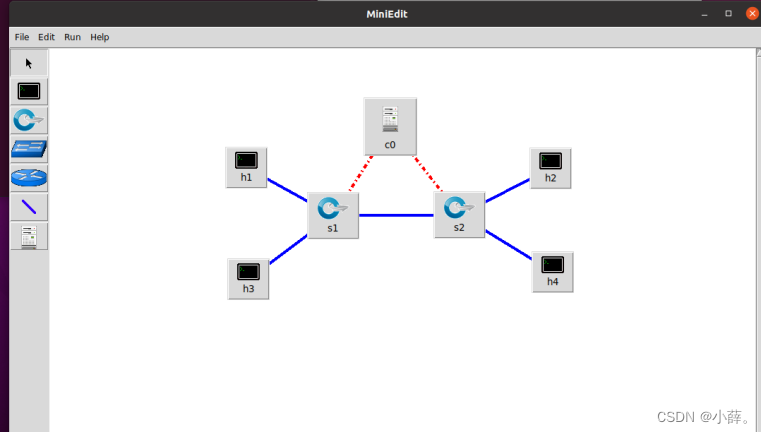
- 配置网段

- 配置IP地址
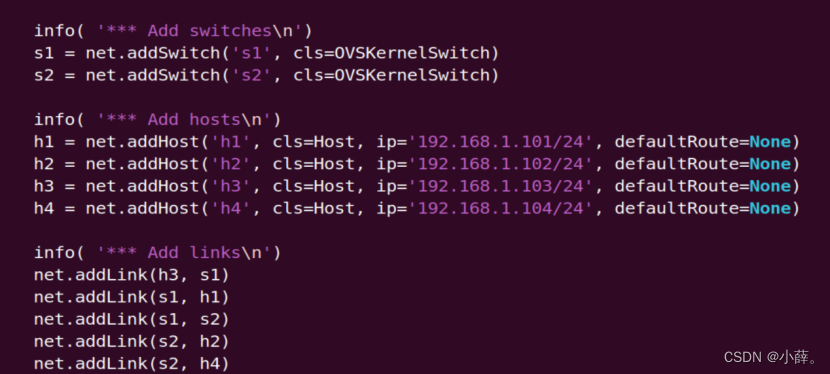
- 保存为py文件

2.查看抓包结果,分析OpenFlow协议中交换机与控制器的消息交互过程,画出相关交互图或流程图。
(1)Hello
- 控制器6633端口(我最高能支持OpenFlow 1.0) ---> 交换机34090端口
- 交换机34090端口(我最高能支持OpenFlow 1.5)--- 控制器6633端口

- 于是双方建立连接,并使用OpenFlow 1.0
(2)Features Request / Set Conig
- 控制器6633端口(我需要你的特征信息) ---> 交换机34090端口

(3)Port_Status
- 当交换机端口发生变化时,告知控制器相应的端口状态。
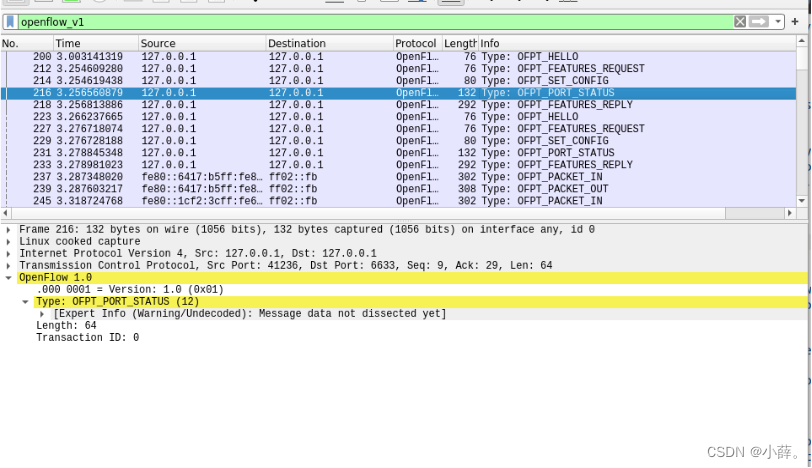
(4)Features Reply
- 交换机34090端口(这是我的特征信息,请查收)--- 控制器6633端口
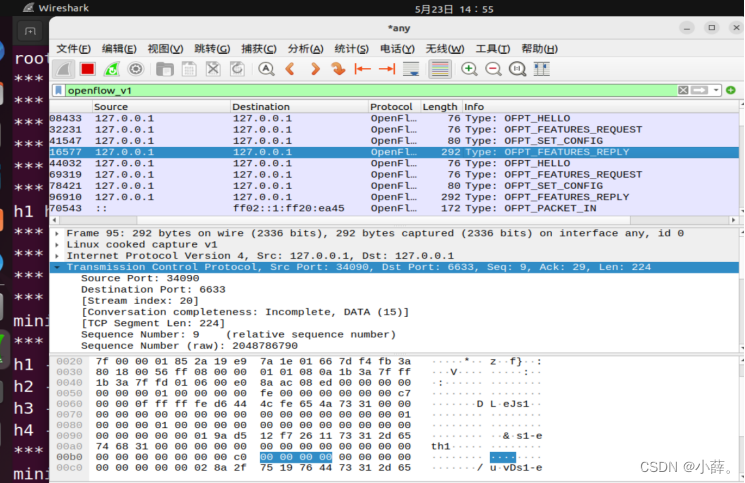
(5)Packet_in
- 有两种情况:
- 交换机查找流表,发现没有匹配条目时
- 有匹配条目但是对应的action是OUTPUT=CONTROLLER时
- 交换机34096端口(有数据包进来,请指示)--- 控制器6633端口
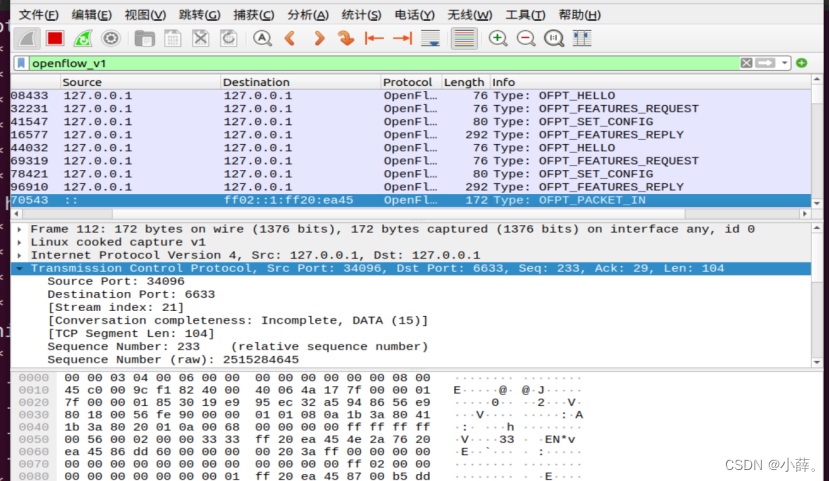
- 分析抓取的数据包,可以发现是因为交换机发现此时自己并没有匹配的流表(Reason: No matching flow (table-miss flow entry) (0)),所以要问控制器如何处理
(6)Flow_mod
- 分析抓取的flow_mod数据包,控制器通过6633端口向交换机34096端口下发流表项,指导数据的转发处理
- 分析抓取的flow_mod数据包,控制器通过6633端口向交换机34096端口下发流表项,指导数据的转发处理
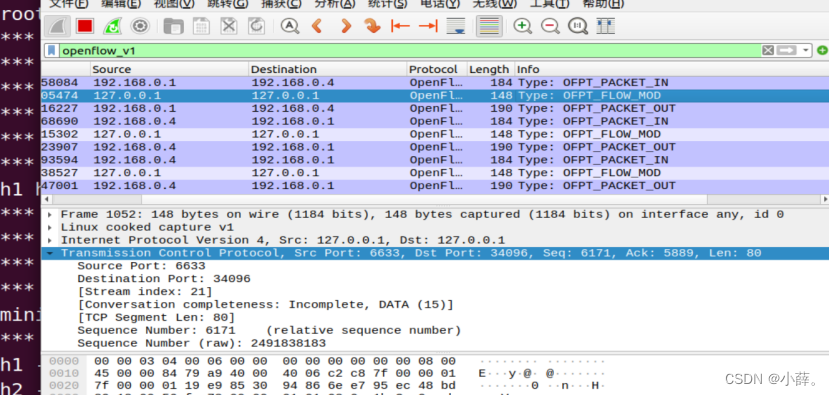
(7)Packet_out
- 控制器6633端口(请按照我给你的action进行处理) ---> 交换机34096端口
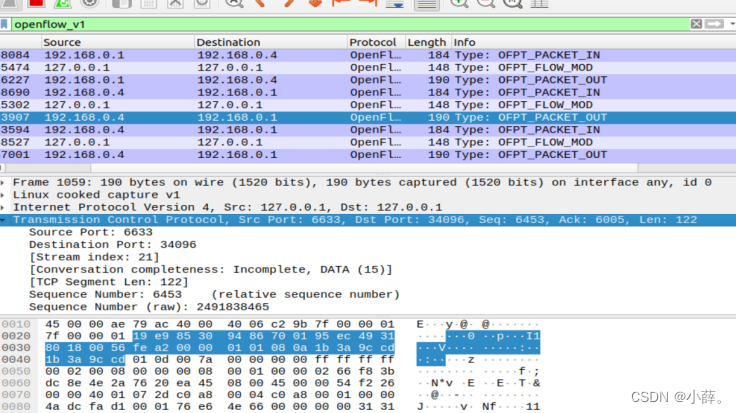
(8)交互图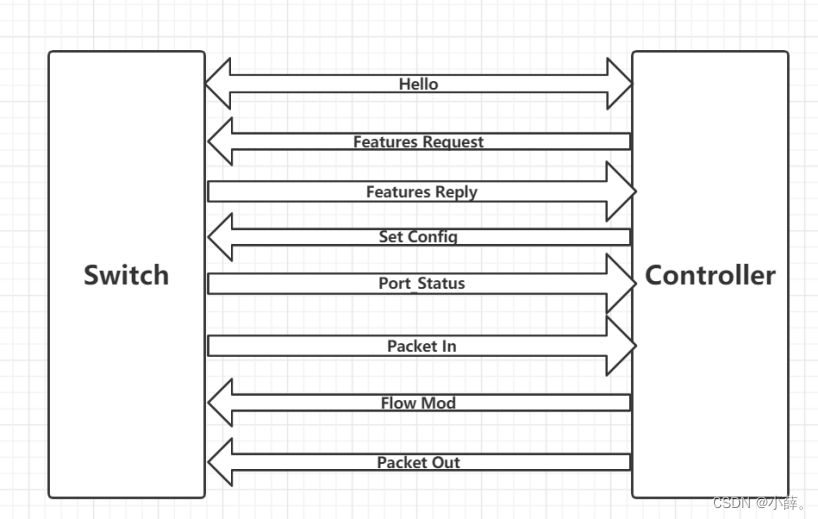
3.回答问题:交换机与控制器建立通信时是使用TCP协议还是UDP协议?
分析wireshark抓包,可以看出交换器与控制器建立通信时使用的是TCP协议。
(二)进阶要求
1.将抓包结果对照OpenFlow源码,了解OpenFlow主要消息类型对应的数据结构定义。
(1)Hello
struct ofp_header {
uint8_t version; /* OFP_VERSION. */
uint8_t type; /* One of the OFPT_ constants. */
uint16_t length; /* Length including this ofp_header. */
uint32_t xid; /* Transaction id associated with this packet.
Replies use the same id as was in the request
to facilitate pairing. */
};/* OFPT_HELLO. This message has an empty body, but implementations must
* ignore any data included in the body, to allow for future extensions. */struct ofp_hello {
struct ofp_header header;
};
- 对应
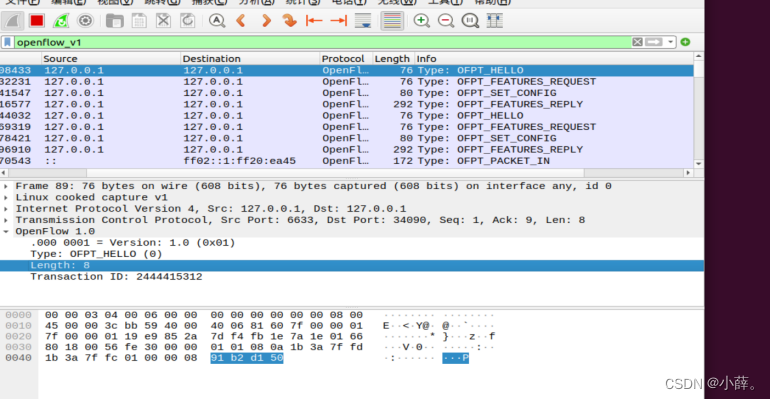
(2)Features Request
- 与Hello中的数据格式相同

(3)Port_Status
/* A physical port has changed in the datapath */struct ofp_port_status {
struct ofp_header header;
uint8_t reason; /* One of OFPPR_*. */
uint8_t pad[7]; /* Align to 64-bits. */
struct ofp_phy_port desc;
};
- 对应

(4)Features Reply
/* Description of a physical port */struct ofp_phy_port {
uint16_t port_no;
uint8_t hw_addr[OFP_ETH_ALEN];
char name[OFP_MAX_PORT_NAME_LEN]; /* Null-terminated */
uint32_t config; /* Bitmap of OFPPC_* flags. */
uint32_t state; /* Bitmap of OFPPS_* flags. */
/* Bitmaps of OFPPF_* that describe features. All bits zeroed if
* unsupported or unavailable. */
uint32_t curr; /* Current features. */
uint32_t advertised; /* Features being advertised by the port. */
uint32_t supported; /* Features supported by the port. */
uint32_t peer; /* Features advertised by peer. */
};/* Switch features. */struct ofp_switch_features {
struct ofp_header header;
uint64_t datapath_id; /* Datapath unique ID. The lower 48-bits are for
a MAC address, while the upper 16-bits are
implementer-defined. */
uint32_t n_buffers; /* Max packets buffered at once. */
uint8_t n_tables; /* Number of tables supported by datapath. */
uint8_t pad[3]; /* Align to 64-bits. */
/* Features. */
uint32_t capabilities; /* Bitmap of support "ofp_capabilities". */
uint32_t actions; /* Bitmap of supported "ofp_action_type"s. */
/* Port info.*/
struct ofp_phy_port ports[0]; /* Port definitions. The number of ports
is inferred from the length field in
the header. */
};
- 对应
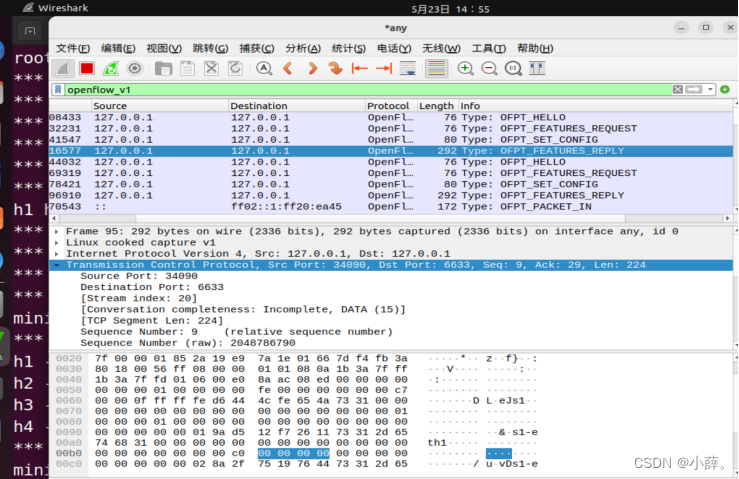
(5)Packet_in
/* Why is this packet being sent to the controller? */enum ofp_packet_in_reason {
OFPR_NO_MATCH, /* No matching flow. */
OFPR_ACTION /* Action explicitly output to controller. */
};
/* Packet received on port (datapath -> controller). */struct ofp_packet_in {
struct ofp_header header;
uint32_t buffer_id; /* ID assigned by datapath. */
uint16_t total_len; /* Full length of frame. */
uint16_t in_port; /* Port on which frame was received. */
uint8_t reason; /* Reason packet is being sent (one of OFPR_*) */
uint8_t pad;
uint8_t data[0]; /* Ethernet frame, halfway through 32-bit word,
so the IP header is 32-bit aligned. The
amount of data is inferred from the length
field in the header. Because of padding,
offsetof(struct ofp_packet_in, data) ==
sizeof(struct ofp_packet_in) - 2. */
};
- 对应
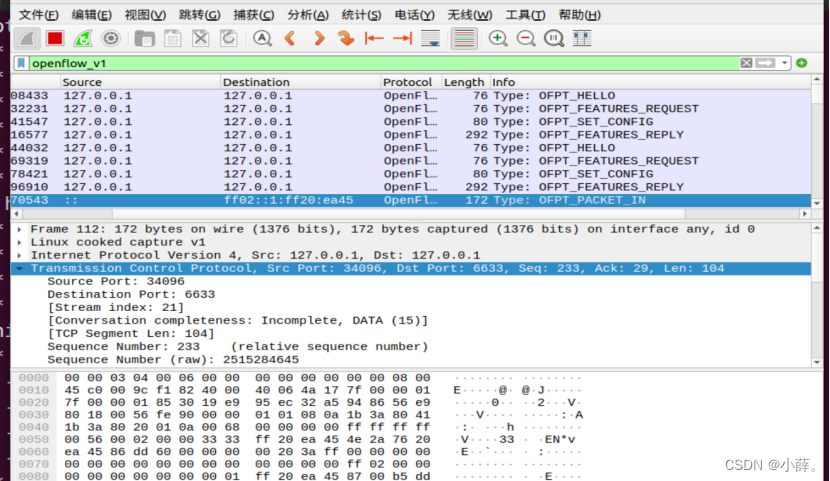
(6)Flow_mod
/* Fields to match against flows */struct ofp_match {
uint32_t wildcards; /* Wildcard fields. */
uint16_t in_port; /* Input switch port. */
uint8_t dl_src[OFP_ETH_ALEN]; /* Ethernet source address. */
uint8_t dl_dst[OFP_ETH_ALEN]; /* Ethernet destination address. */
uint16_t dl_vlan; /* Input VLAN id. */
uint8_t dl_vlan_pcp; /* Input VLAN priority. */
uint8_t pad1[1]; /* Align to 64-bits */
uint16_t dl_type; /* Ethernet frame type. */
uint8_t nw_tos; /* IP ToS (actually DSCP field, 6 bits). */
uint8_t nw_proto; /* IP protocol or lower 8 bits of
* ARP opcode. */
uint8_t pad2[2]; /* Align to 64-bits */
uint32_t nw_src; /* IP source address. */
uint32_t nw_dst; /* IP destination address. */
uint16_t tp_src; /* TCP/UDP source port. */
uint16_t tp_dst; /* TCP/UDP destination port. */
};/* Flow setup and teardown (controller -> datapath). */struct ofp_flow_mod {
struct ofp_header header;
struct ofp_match match; /* Fields to match */
uint64_t cookie; /* Opaque controller-issued identifier. */
/* Flow actions. */
uint16_t command; /* One of OFPFC_*. */
uint16_t idle_timeout; /* Idle time before discarding (seconds). */
uint16_t hard_timeout; /* Max time before discarding (seconds). */
uint16_t priority; /* Priority level of flow entry. */
uint32_t buffer_id; /* Buffered packet to apply to (or -1).
Not meaningful for OFPFC_DELETE*. */
uint16_t out_port; /* For OFPFC_DELETE* commands, require
matching entries to include this as an
output port. A value of OFPP_NONE
indicates no restriction. */
uint16_t flags; /* One of OFPFF_*. */
struct ofp_action_header actions[0]; /* The action length is inferred
from the length field in the
header. */
};
- 对应
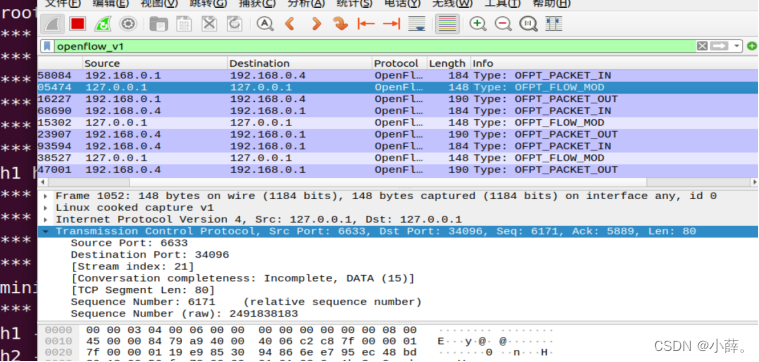
(7)Packet_out
/* Action header that is common to all actions. The length includes the
* header and any padding used to make the action 64-bit aligned.
* NB: The length of an action *must* always be a multiple of eight. */struct ofp_action_header {
uint16_t type; /* One of OFPAT_*. */
uint16_t len; /* Length of action, including this
header. This is the length of action,
including any padding to make it
64-bit aligned. */
uint8_t pad[4];
};OFP_ASSERT(sizeof(struct ofp_action_header) == 8);
/* Send packet (controller -> datapath). */struct ofp_packet_out {
struct ofp_header header;
uint32_t buffer_id; /* ID assigned by datapath (-1 if none). */
uint16_t in_port; /* Packet's input port (OFPP_NONE if none). */
uint16_t actions_len; /* Size of action array in bytes. */
struct ofp_action_header actions[0]; /* Actions. */
/* uint8_t data[0]; */ /* Packet data. The length is inferred
from the length field in the header.
(Only meaningful if buffer_id == -1.) */
};
- 对应
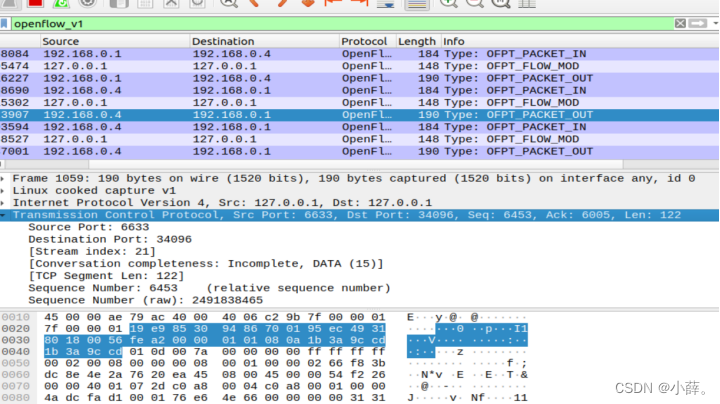
四、个人总结
- 实验难度:适中
- 实验过程遇到的困难及解决办法:
- 本次实践不算太难,主要就是分析抓包的结果,跟着pdf就可以做出来,对这个OpenFlow 交换机与控制器交互过程有所了解。对于hello,对wireshark抓包的过程更加熟悉。进阶的时候需要打开openflow.h里面查看数据结构,代码量还是挺多的,在里面找结构有点困难,找了很长时间才找出主要消息类型的结构构成。遇到的主要的问题就是有可能会出现抓包找不到HELLO的情况,问题在于要先开启wires hark然后点出any,再构建拓扑,没打开any后面抓包是抓不到HELLO的,因为可能在抓包之前就已经进行过HELLO了,所以要先打开wires hark的any再构建拓扑。
- 个人感想: 通过本次实验的学习,学习了利用过滤器对抓取的数据包并用过滤方法来找到所需要的数据包。同时在抓包结果与openflow头文件源码对照学习中更了解openflow主要消息类型对应的数据结构定义,OpenFlow协议的数据包交互过程与机制。





















 1941
1941

 被折叠的 条评论
为什么被折叠?
被折叠的 条评论
为什么被折叠?








